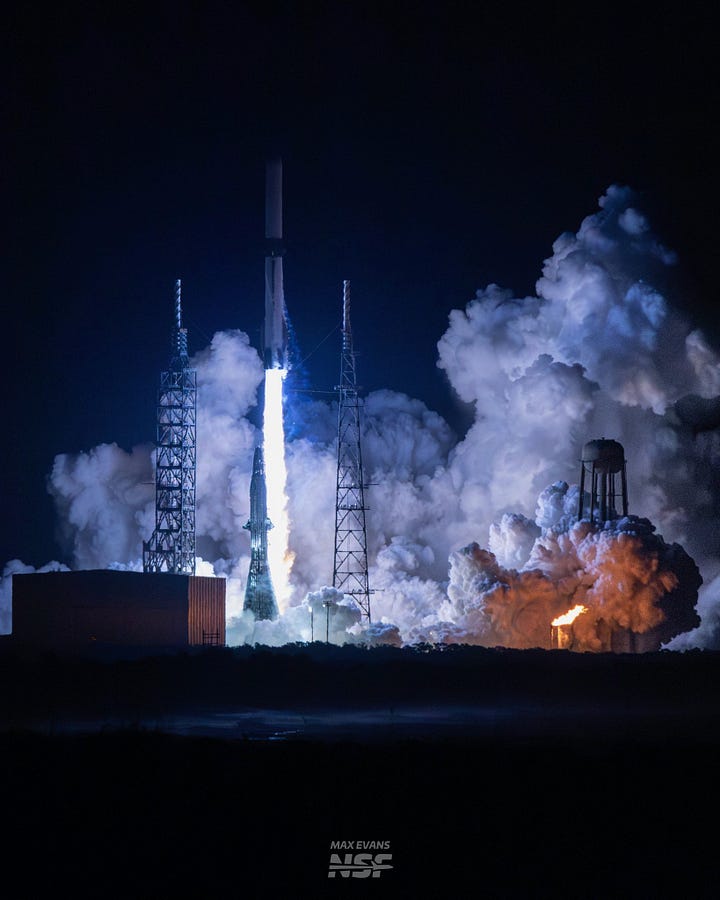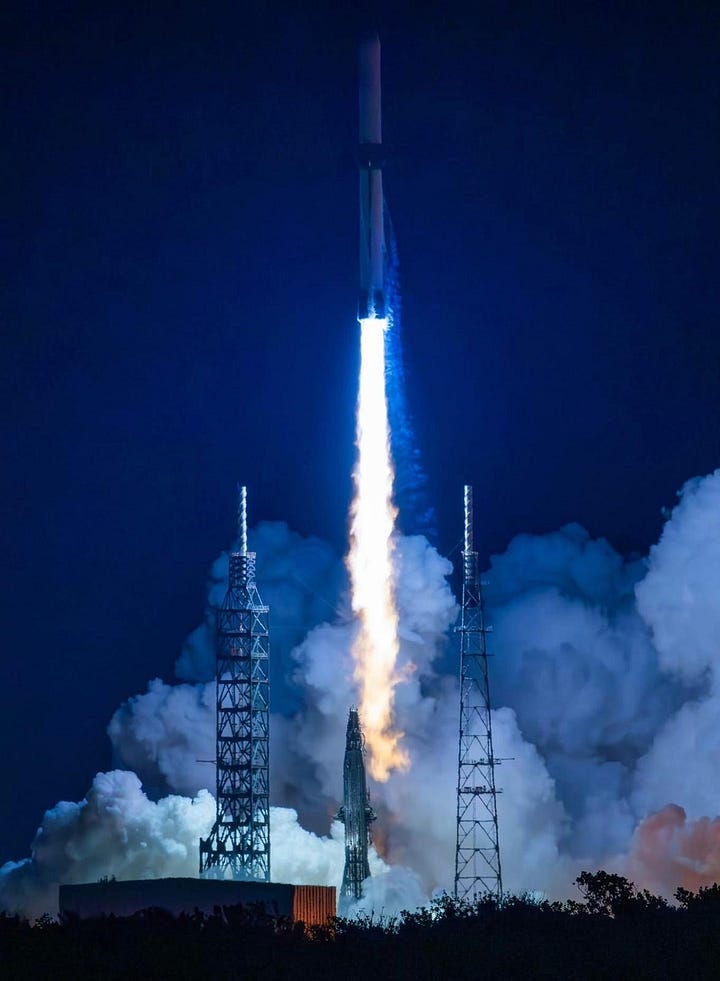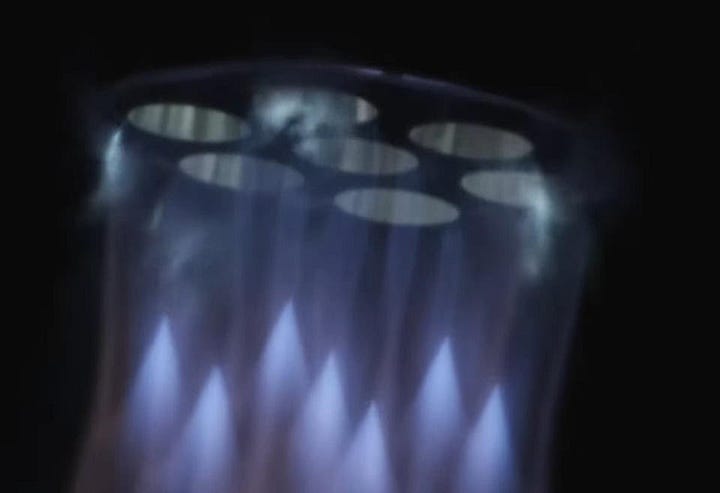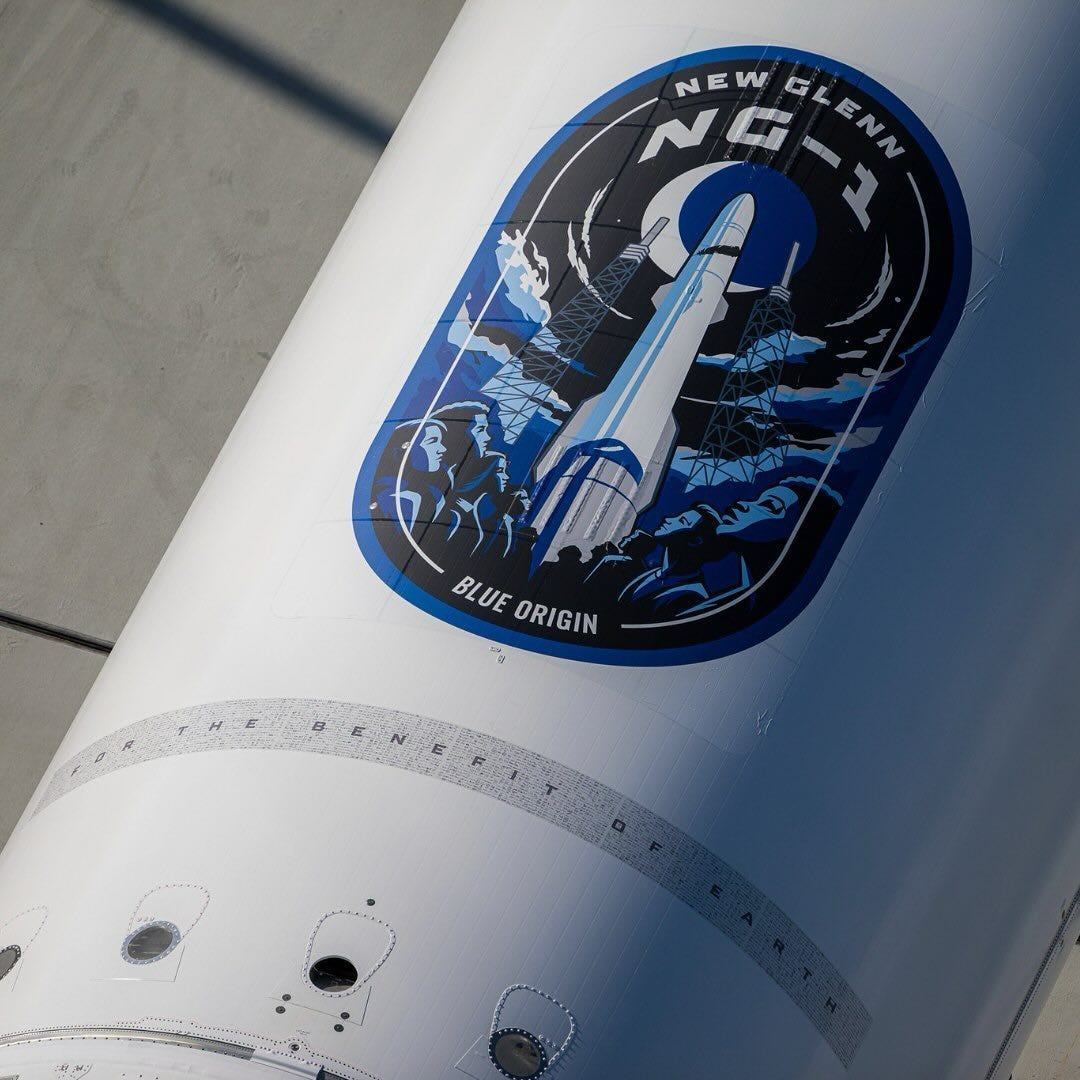The Future Burns Bright Blue
Blue Origin debuted New Glenn, and with it? Hope for a brighter future, for humanity.
In these troubled times, a ray of cynicism-erasing hope arose, into the early morning skies, over the both literal and metaphorical swamps of Florida, after days of delays, on Thursday, January 16, 2025, at 2:03 a.m. EST:
New Glenn.
I was at KARS Park, on Merritt Island, Florida, to watch the successful launch of Blue Origin’s entry into the Corporate Space Race, New Glenn 1, rise into both the future, and history, from Launch Complex 36, at Florida’s Cape Canaveral Space Force Station.
Yes, they sought permission from legendary astronaut John Glenn, before he passed, to name the rocket after him. What a long-term, long-range honor is this next “giant leap” off of the planet?
New Glenn is designed to carry heavy payloads into space. At 320-feet-tall (approximately 98 meters) and about 7 meters across, at its base, with a payload bay bigger than that of the Space Shuttle, it is now the largest single rocket in commercial service.
Space X’s Starship, after it can reach Low-Earth Orbit (LEO), without breaking up, will be taller, and carry more weight there. It’s not built for much else, though.
New Glenn’s first stage (booster) is powered by seven of Blue Origin’s BE-4 engines, which use liquid oxygen (LOX) and Liquified Natural Gas (LNG) as propellants. They offer advantages in terms of performance, cost-efficiency, and versatility. Looking at the photos below, they’re also a whole lot prettier to watch go up!
This configuration enables New Glenn to deliver substantial payloads to various orbits, including low Earth orbit (LEO) and Medium Earth Orbit, and Geostationary Transfer Orbit (GTO).




New Glenn-1 fulfilled its mission, of sending the second stage into orbit, and delivering part of the Blue Ring Pathfinder project, into medium Earth orbit (MEO).
Blue Ring is called a “space mobility platform.” It’s designed to maneuver to various orbits, where it can deploy payloads brought up by heavy-lift spacecraft.
Secondary Objective: First to Land, First Try? Nope.
“So You're Telling Me There's a Chance,” as the first stage was named, was hoped, by the Blue Origin team, to be the first successful first-time-launched-and-landed main stage. It failed to land on the drone ship “Jacklyn,” though, a few hundred miles down-range, in the Atlantic Ocean. This will become the focus of a lot of hours of study, prior to getting the second New Glenn rocket on to the pad.
Third Objective: Delivering a New School of Space Delivery
Everyone, in the commercial rocket biz, has been searching for the Holy Grail of reliable space delivery, post Space Shuttle. There are going to be a lot of theories of the case. Blue Origin made theirs, early Thursday morning.
Reusability
Blue Origin was the first to successfully land a suborbital rocket, its New Shepard rocket, in November, of 2015.
SpaceX was the first to land an orbital-class rocket, a month later, with Falcon 9, in December, of 2015.
Blue Origin’s revolutionary BE-4 engines are cleaner burning, more cost efficient, and improve reusability of engines and tubes, in turnarounds.
They were also used on United Launch Alliance’s Vulcan Centaur rocket, a part of NASA’s Artemis lunar program, to replace Russian-made RD-180 engines, previously used in its Atlas V rockets. Eliminating the need for a foreign adversary’s equipment, in a time of political turmoil, improves deliverability and long-term viability.
Duration
Going the distance is going to be key to establishing more of a human presence in space, from geostationary orbiting factories, and laboratories, to lunar bases, and beyond.
Blue Origin’s BE-3U engines, on the second stage of New Glenn, are optimized for operating in the vacuum of space. It can deliver payloads to geostationary orbit, moon missions, and, possibly deep space missions, as well.
The Real Future Isn’t on the Rockets, Though.
As amazing as it is to see this incredible machine rise into the sky, a modern phoenix rising from the ashes of a government-only space program, one could cynically look at the millions being poured into programs by deep-pocket billionaires’ private companies as some exotic, high-tech form of polo.
It isn’t, though.
I was honored to be a guest of the thousands of people whose hundreds of thousands of man-hours, creativity, and invention have been brought to bear to meet the scientific challenges, and objectives of this century, and beyond.
They will deliver, for humanity, improvements in:
how we live;
radical changes to our naive, nativist economics;
our health, and welfare;
a pathway to both improve our planet
exploration of the marvels, and opportunities, of human life amongst the stars.
We hear a lot of very underwhelming things about the younger generations being less intellectually curious; tuned out; lost in digital worlds; struggling with human connection.
Over the week that it took, to get New Glenn’s maiden voyage off of the ground, I met hundreds of people who defy those stereotypes. They are engaged in creating, from the shoulders of the giants, and a lot of their own new-fangled ideas, and aspirations, one of the greatest advances in human history.
At a time, where being smart is often derided, by people who proudly don’t want to understand this sentence, ignorance is more often bliss, and grand human achievements have lost their luster, I walked amongst these small giants.
Thousands of incredible human beings, filled with a passion to: find the unfound; to push the limitations of humanity to its best days, not crawl back to its worst. They focus on their areas, with incredible dedication, and commitment. Like a symphony, it all comes together, in a few beautiful, brief moments, that make every effort worth it.
New Glenn, beneath it’s shield, has a stripe, filled with the signatures of everyone who has worked on the rocket, with the motto “For the Benefit of Earth”
There is a culture, at Blue Origin, that is not born of PR first, and a lot of boasting, but of a greater power. The common aspiration, of an impossibly big dream, accomplished only by thousands of the best engineers, and technicians, doing the daily grind; forging ideas into the state-of-the-art; achieving mankind’s manifest destinies.
They continually remind the rest of us, who aren’t “rocket scientists,” that we don’t have to look to the heavens, or to our leaders, to be our best selves, or to improve the world around us.
We, too, can do the impossible, and make our Earth, our lives, magical, if we try.
Esse optimum, esse optimum sui.





